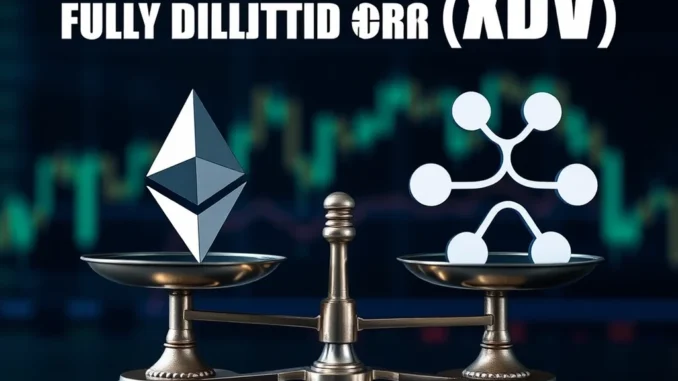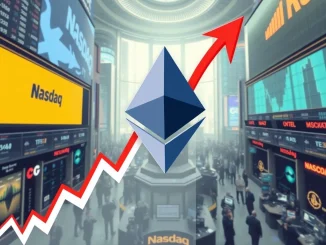
In the ever-evolving world of cryptocurrency, market capitalization and trading volumes often dominate headlines. However, a less discussed yet equally crucial metric is Fully Diluted Valuation (FDV). Currently, Ethereum (ETH) holds a slight advantage over XRP in terms of FDV, but as market dynamics shift, this lead could be precarious. Let’s dive into what FDV means, why it matters, and explore the fascinating dynamic between Ethereum and XRP.
Decoding Cryptocurrency Valuation: Understanding Fully Diluted Valuation (FDV)
Before we delve into the ETH vs XRP comparison, it’s crucial to understand what Fully Diluted Valuation (FDV) actually represents. In simple terms, FDV offers a glimpse into the potential future market cap of a cryptocurrency if its entire maximum supply were in circulation today. It’s calculated with a straightforward formula:
FDV = Current Token Price x Maximum Token Supply
Let’s break this down further:
- Current Token Price: This is the real-time price at which a cryptocurrency is trading on exchanges.
- Maximum Token Supply: This refers to the total number of tokens that will ever exist for a particular cryptocurrency. For some cryptos like Bitcoin and XRP, this supply is fixed. For others like Ethereum, while there isn’t a hard cap, the issuance rate is managed.
Why is FDV important? It provides a broader perspective beyond the circulating supply. Imagine two cryptocurrencies with the same current market cap. However, one might have a significantly larger maximum supply than the other. The cryptocurrency with the larger maximum supply, despite having the same current market cap, will likely have a lower price per token when all tokens are eventually in circulation. FDV helps investors understand this potential dilution.
Ethereum’s FDV Edge: A Closer Look at the Numbers
As per recent CoinMarketCap data, Ethereum’s FDV currently stands at $228.08 billion. This valuation reflects the current price of ETH multiplied by the approximate 120 million ETH currently in circulation. It’s important to note that while Ethereum doesn’t have a strict maximum supply like Bitcoin, its annual issuance rate is designed to be predictable and controlled. This makes the concept of FDV still relevant for ETH, even if the ‘maximum’ supply is theoretically infinite in the very long run.
Ethereum’s robust ecosystem, encompassing decentralized applications (dApps), NFTs, and a thriving developer community, significantly contributes to its perceived value and, consequently, its FDV. The ongoing transition to Proof-of-Stake (PoS) with the Merge and subsequent upgrades are also seen as positive catalysts for Ethereum’s long-term value proposition.
XRP’s FDV Position: A Fixed Supply and Market Dynamics
In contrast to Ethereum, XRP boasts a fixed maximum supply of 100 billion tokens. With its current price, XRP’s Fully Diluted Valuation is around $218.67 billion, placing it slightly behind Ethereum. XRP’s primary use case is focused on facilitating faster and cheaper cross-border payments for financial institutions. Its FDV reflects investor sentiment regarding its potential adoption in the traditional finance sector and its ability to disrupt existing payment systems.
However, XRP has faced regulatory challenges in the past, which have impacted its price and overall market perception. The ongoing legal battles and their outcomes play a significant role in shaping investor confidence and, subsequently, XRP’s valuation metrics, including FDV.
The Potential Shift: Factors Influencing a Change in FDV Rankings
While Ethereum currently maintains a lead in FDV over XRP, the cryptocurrency market is notoriously volatile. A shift in these rankings is not only possible but could occur rapidly. Several factors could trigger such a change:
- Price Fluctuations: The most direct factor is price movement. A significant surge in XRP’s price, even without a change in circulating supply, could propel its FDV above Ethereum’s. Conversely, a price correction for ETH could narrow the gap or even reverse the positions.
- Market Sentiment: Overall market sentiment towards each cryptocurrency plays a crucial role. Positive news, technological advancements, or increased adoption can boost investor confidence and drive up prices, impacting FDV. Negative news or regulatory hurdles can have the opposite effect.
- Technological Developments: Successful upgrades and advancements in either Ethereum or XRP’s underlying technology can influence their perceived value. For Ethereum, continued success with its scalability roadmap and ecosystem growth is vital. For XRP, progress in its adoption by financial institutions and clarity on its regulatory status are key.
- Broader Economic Conditions: Macroeconomic factors, such as inflation, interest rates, and global economic stability, can impact the entire cryptocurrency market, influencing both ETH and XRP valuations.
It’s important to remember that FDV is just one metric among many to consider when evaluating cryptocurrencies. It should be used in conjunction with other indicators like market capitalization, trading volume, technology, use cases, and team strength for a comprehensive assessment.
Navigating Cryptocurrency Valuation: Actionable Insights for Investors
So, what does this FDV comparison mean for cryptocurrency investors? Here are some actionable insights:
- Don’t solely rely on FDV: FDV is a valuable tool, but it shouldn’t be the only metric guiding your investment decisions. Consider it alongside other fundamental and technical analysis indicators.
- Understand tokenomics: Pay close attention to the tokenomics of each cryptocurrency, including maximum supply, circulating supply, and token distribution. This understanding is crucial for interpreting FDV accurately.
- Stay informed: Keep abreast of the latest news and developments in the cryptocurrency space, particularly concerning Ethereum and XRP. Regulatory updates, technological advancements, and market sentiment shifts can significantly impact valuations.
- Consider long-term potential: FDV is a forward-looking metric. Evaluate the long-term potential of both Ethereum and XRP based on their use cases, technology, and adoption prospects, rather than just focusing on current FDV rankings.
Conclusion: The Dynamic Dance of Crypto Valuations
The current FDV landscape, with Ethereum leading XRP, provides a snapshot of the ever-shifting dynamics within the cryptocurrency market. While Ethereum currently holds the advantage, the potential for a shift remains a compelling narrative. By understanding FDV and considering the various factors that influence cryptocurrency valuations, investors can navigate this exciting and often unpredictable space with greater clarity and make more informed decisions. The race between Ethereum and XRP, as reflected in their FDV, is a fascinating example of the ongoing evolution of the digital asset ecosystem, and it’s one that market participants should continue to watch closely.



